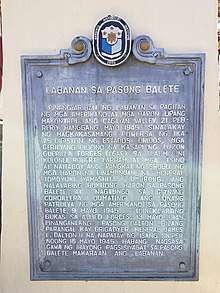Robert Lapham
Robert Lapham (January 1, 1917 – December 18, 2003 in Sun City, Arizona) was a reserve lieutenant in the US Army in World War II.
Robert Lapham | |
|---|---|
Robert Lapham (third from left) | |
| Born | January 1, 1917 Davenport, Iowa |
| Died | December 18, 2003 (aged 86) Sun City, Arizona |
| Allegiance | |
| Service/ | |
| Years of service | 1941–1945 |
| Rank | |
| Unit | 45th Infantry Regiment (PS) |
| Battles/wars | World War II |
| Awards | Distinguished Service Cross Philippine Legion of Honor |
He served in the Philippines attached to the 45th Infantry (Philippine Scouts),[1]:4 evaded capture in the spring of 1942, and organized a guerrilla regiment in the Central Plains of the northern island of Luzon. He was promoted to major by war's end, age 28, and was awarded the Distinguished Service Cross by General Douglas MacArthur. Lapham was the third person, after President Franklin Delano Roosevelt and MacArthur, to receive the Philippine Legion of Honor.[1]:241
Biography
Early life
A graduate of the University of Iowa in 1939 with an ROTC 2nd lieutenant's commission in the Army Reserve, Lapham worked for the Chicago branch of the Burroughs Corporation before signing up for active duty in May 1941.[1]:xi-xii He was assigned to the Philippines and arrived Manila on June 25, 1941, and stationed at Fort William McKinley.[1]:6–7
Bataan
After MacArthur was evacuated to Australia, General Jonathan Wainwright was given command of the Philippine defense force. As talk of surrender began, Lapham sneaked through the lines. In his 1996 book, Lapham’s Raiders: Guerrillas in the Philippines, 1942–45, he explained why he headed to the jungles to fight: "Somehow, I didn’t like the idea of surrendering. I felt I had better chances on the outside than in a Japanese prison camp."
Lapham joined Major Claude A. Thorp in organizing "a raiding party that would slip through Japanese lines", sabotage Clark Field and gather intelligence for General MacArthur.[1]:13–14 On January 27, 1942, they passed through Japanese lines into the Zambales Mountains, finally reaching Mount Pinatubo, where they established Camp Four or Camp Sanchez, and the newly promoted Lieutenant Colonel Thorp established radio communication with Bataan.[1]:18–19 After the fall of Bataan, Thorp released his approximately one hundred men from following his orders, allowing them to surrender, stay or follow their own path.[1]:22
Lapham and Sergeants Albert Short and Esteban Lumyeb, started north, eventually making it to Lupao, Nueva Ecija, where they were joined by Sergeant Estipona and other soldiers.[1]:24 Lapham went on to establish another camp in Umingan, Pangasinan.[1]:25 By May 1942, he had a company of men in both locations, and his Luzon Guerrilla Army Force (LGAF) would dominate the northern Luzon central plain.[1]:28
According to Lapham, "Most of the guerrilla leaders who died in the war were killed or captured in its first year...", while the rest, "...had managed to eliminate or chase off spies and collaborators...learned how to win the support and trust of civilians...had succeeded in establishing effective spy systems of our own...had learned when to hide out and when to show ourselves..."[1]:54–55
Luzon Guerrilla

In 1943 and 1944, the estimated 13,000 Filipinos under Lapham's command in the Luzon Guerrilla Armed Forces (LGAF), engaged in "harassing the Japanese more than they had in 1942.[1]:55 This included 38 squadrons in Nueva Ecija under Captain Harry McKenzie, 15 in Pangasinan under Captain Ray C. Hunt, and six in Tarlac under Captain Al Hendrickson.[1]:70 He also had coast watcher units at Baler Bay, Caranglan and Pantabangan, and a combat unit of southwest Pampanga under the command of Emilio and Tony Hernandez.[1]:74 Lapham also managed to evacuate Captain Wilbur Lage and other Americans to Australia via submarine.[1]:74 In mid-1944, he received radio transmitters and started sending intelligence information to Australia.[1]:89 This was followed by 30 tons of supplies from the USS Narwhal (SS-167) in August 1944, and another 20 tons from the USS Nautilus (SS-168) in Oct.[1]:151–157
On January 4, 1945, his forces initiated four days of sabotage in support of the Battle of Luzon.[1]:226 On January 8, Lapham linked up with General Walter Krueger's US 6th Army.[1]:226 Lapham then formed the 1st Infantry Regiment, which was attached to the 25th Division on January 20.[1]:184
The Japanese army put a $1 million bounty on his head.
Lapham is credited for bringing the perilous situation of the 513 Allied POWs and internees remaining in the Cabanatuan Japanese POW camp to the attention of the American forces then fighting their way across Luzon towards Manila in January 1945. The POWs, captured after the fall of Corregidor and Bataan in 1942, had not been shipped to Japan because they were considered too ill or unfit. Lapham's was concerned the POWs would be executed before the camp could be liberated. His concerns were well justified given the August 1944 Japanese War Ministry directive to commandants of POW camps outlining the final disposition of prisoners (known as the "August 1 Kill-All Order"), and the killing of 139 American POWs by the Japanese at Palawan, Philippines on 14 December 1944. Lapham's efforts lead to a rescue mission on January 30, 1945, by 121 members of the US Army's 6th Ranger Battalion, and two teams of Alamo Scouts, who marched 30 miles (48 km) behind enemy lines, eliminated the Japanese forces securing the camp, liberated its 513 prisoners and returned them to American lines.[1]:176–181
By May 31, 1945, Lapham had 79 squadrons, 809 officers and 13,382 men, who suffered 813 casualties.[1]:226
After the war
Lapham returned to Burroughs (now Unisys) after the war. In 1975, he retired as vice president for industrial relations,[1]:243 in Detroit.
See also
References
- Lapham, R., and Norling, B., 1996, Lapham's Raiders, Lexington: The University Press of Kentucky, ISBN 0813119499